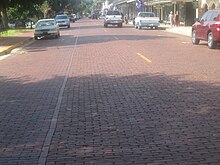Brick
Middle East and South Asia
The earliest bricks were dried brick, meaning that they were formed from clay-bearing earth or mud and dried (usually in the sun) until they were strong enough for use. The oldest discovered bricks, originally made from shaped mud and dating before 7500 BC, were found at Tell Aswad, in the upper Tigris region and in southeast Anatolia close to Diyarbakir.[1] The South Asian inhabitants of Mehrgarh also constructed, and lived in, airdried mudbrick houses between 7000–3300 BC.[2] Other more recent findings, dated between 7,000 and 6,395 BC, come from Jericho, Catal Hüyük, the ancient Egyptian fortress of Buhen, and the ancient Indus Valley cities of Mohenjo-daro, Harappa,[3] and Mehrgarh.[4] Ceramic, or fired brick was used as early as 3000 BC in early Indus Valley cities like Kalibangan.[5]
China
The earliest fired bricks appeared in Neolithic China around 4400 BC at Chengtoushan, a walled settlement of the Daxi culture.[6] These bricks were made of red clay, fired on all sides to above 600 °C, and used as flooring for houses. By the Qujialing period (3300 BC), fired bricks were being used to pave roads and as building foundations at Chengtoushan.[7]
Bricks continued to be used during 2nd millennium BC at a site near Xi'an.[8] Fired bricks were found in Western Zhou (1046–771 BC) ruins, where they were produced on a large scale.[9][10][11] The carpenter's manual Yingzao Fashi, published in 1103 at the time of the Song dynasty described the brick making process and glazing techniques then in use. Using the 17th-century encyclopaedic text Tiangong Kaiwu, historian Timothy Brook outlined the brick production process of Ming Dynasty China:
Europe
Early civilisations around the Mediterranean adopted the use of fired bricks, including the Ancient Greeksand Romans. The Roman legions operated mobile kilns,[12] and built large brick structures throughout the Roman Empire, stamping the bricks with the seal of the legion.
During the Early Middle Ages the use of bricks in construction became popular in Northern Europe, after being introduced there from Northern-Western Italy. An independent style of brick architecture, known as brick Gothic (similar to Gothic architecture) flourished in places that lacked indigenous sources of rocks. Examples of this architectural style can be found in modern-day Denmark, Germany, Poland, and Russia.
This style evolved into Brick Renaissance as the stylistic changes associated with the Italian Renaissance spread to northern Europe, leading to the adoption of Renaissance elements into brick building. A clear distinction between the two styles only developed at the transition to Baroque architecture. In Lübeck, for example, Brick Renaissance is clearly recognisable in buildings equipped with terracotta reliefs by the artist Statius von Düren, who was also active at Schwerin (Schwerin Castle) and Wismar (Fürstenhof).
Long-distance bulk transport of bricks and other construction equipment remained prohibitively expensive until the development of modern transportation infrastructure, with the construction of canal, roads, and railways.
Industrial era
Production of bricks increased massively with the onset of the Industrial Revolution and the rise in factory building in England. For reasons of speed and economy, bricks were increasingly preferred as building material to stone, even in areas where the stone was readily available. It was at this time in London that bright red brick was chosen for construction to make the buildings more visible in the heavy fog and to help prevent traffic accidents.[13]
The transition from the traditional method of production known as hand-moulding to a mechanised form of mass-production slowly took place during the first half of the nineteenth century. Possibly the first successful brick-making machine was patented by Henry Clayton, employed at the Atlas Works in Middlesex, England, in 1855, and was capable of producing up to 25,000 bricks daily with minimal supervision.[14] His mechanical apparatus soon achieved widespread attention after it was adopted for use by the South Eastern Railway Company for brick-making at their factory near Folkestone.[15] The Bradley & Craven Ltd ‘Stiff-Plastic Brickmaking Machine’ was patented in 1853, apparently predating Clayton. Bradley & Craven went on to be a dominant manufacturer of brickmaking machinery.[16] Predating both Clayton and Bradley & Craven Ltd. however was the brick making machine patented by Richard A. Ver Valen of Haverstraw, New York in 1852.[17]
The demand for high office building construction at the turn of the 20th century led to a much greater use of cast and wrought iron, and later, steel and concrete. The use of brick for skyscraper construction severely limited the size of the building – the Monadnock Building, built in 1896 in Chicago, required exceptionally thick walls to maintain the structural integrity of its 17 storeys.
Following pioneering work in the 1950s at the Swiss Federal Institute of Technology and the Building Research Establishment in Watford, UK, the use of improved masonry for the construction of tall structures up to 18 storeys high was made viable. However, the use of brick has largely remained restricted to small to medium-sized buildings, as steel and concrete remain superior materials for high-rise construction.[18]







